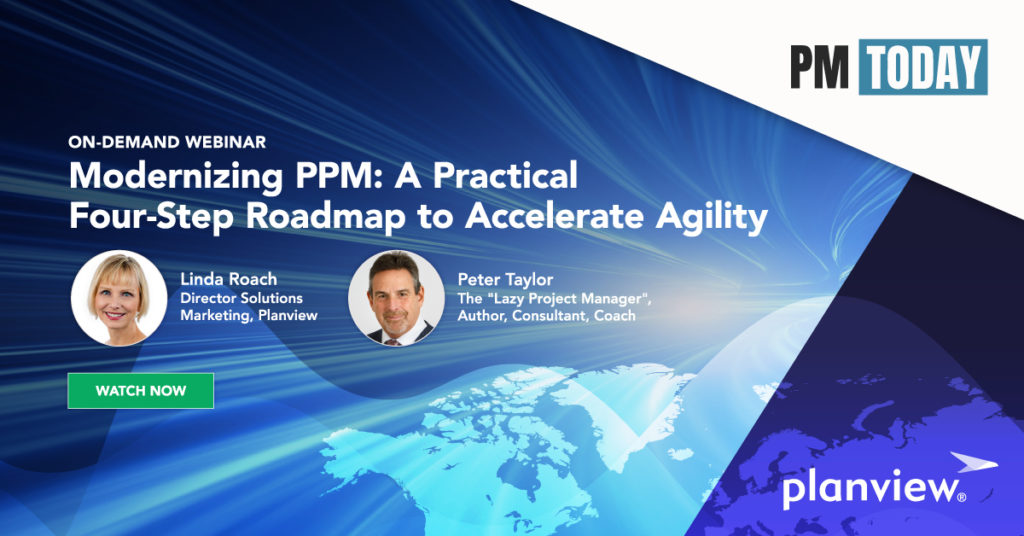
Fresh from achieving great strides in digital transformation and other endeavors in record time over the past year, executives and boards of directors want to inject even more speed and agility into their organization’s DNA. Portfolio Management Offices are in a prime position to deliver this business agility – with the right PMO roadmap.
This is what consultant Peter Taylor and I discussed during our recent webinar: Modernizing PPM: A Practical Four-Step Roadmap to Accelerate Agility.
Peter, who wrote the book The Lazy Project Manager, drew upon his 30 years of experience building and leading PMOs to provide some guideposts. What follows are a few of the compelling questions we received from attendees.
Key Points
First, here’s a quick overview of key points from the webinar:
- (8:25): “The world of the status quo doesn’t exist,” said Peter. “Even in normality that was a dying strategy.” Businesses must build speed and agility into their operations if they want to survive and thrive in a world of constant disruptions, evolving priorities, changing customer demands, and more.
- (34:15): One of the great risks is sticking with the status quo. People are afraid of regressing, according to a recent survey Peter conducted. Their organizations made incredible progress during the pandemic, but old processes and systems are deeply embedded, making change difficult.
- (10:28): I highlighted findings from Planview’s new global benchmark report, The State of Strategy Execution: Embracing Uncertainty to Adapt at Speed. We asked how quickly and at what quality organizations are adapting to change and found a category of “Strategy Execution Leaders.” These companies are driving speed and pivoting to adapt to shifting conditions, volatile challenges, and emerging opportunities. I explained how and what is holding other organizations back.
- (18:40): Why right now is the time for the PMO to rightfully claim its seat at the executive table: PMOs can be the champions of transformations and deliver business value.
- (32:00): The four steps any PMO can take to adapt their PPM practices and accelerate agility, outpacing the competition.
- (33:55): Practical tips, tricks, and toolkits for working smarter – not harder – to empower your teams, get the right work done at the right time, and deliver the portfolio with visibility and clarity.
- (17:45): Peter contributed to the PMO roadmap discussion with insights from his new book – Make Your Business Agile, including the importance of cultivating adaptability, a team-centric focus, and decentralized, fast decision-making and collaboration.

Having an Agile mindset is crucial, which means being flexible and moving swiftly to overcome challenges and achieve outcomes. This includes “unlearning” how you have done things before, especially for PMOs focused on traditionally strict governance, rigid processes, and a project focus.
View the webinar for all the details.
Sample Questions from the Webinar
Attendees asked more questions that we had time for! Here’s a set of those questions.
Speed/Agile is great, but is it always productive and effective to be in constant change without the learnings of what works? How do you calibrate when fast is too fast?
Peter responded that even some of the most rigid, governance-led organizations are moving at unbelievable speeds in a sensible manner. One reason for this is that constant feedback is a core part of the Agile ethos and methodology. Agile teams are always learning, experimenting, and iterating fast.
The PMO roadmap shows how to cultivate effective strategy execution at speed. Part of this is empowering teams by providing “just enough” governance. Teams should be accountable for their work and have the autonomy to determine how to get it done.
This doesn’t mean having zero governance. PMOs should still be responsible for connecting strategy with execution as well as resolving conflicts and dependencies across teams and teams of teams.
In addition, moving at greater speeds requires structure. In the benchmark study, Planview focuses on five steps of responding to change. Mastering these steps enables organizations to pivot quickly and effectively at speed.
Visibility underpins all this. Disparate pockets of information fail to clearly indicate an organization’s progress on key milestones. The ability to access and analyze data to make informed decisions also boosts speed and agility.
Can you go over Lean versus Agile?
Lean and Agile are methodologies and philosophies focused on speed, flexibility, and delivering customer value. Agile methods focus on producing work in frequent iterations and adapting quickly according to customer feedback. Lean is about streamlining processes, managing workflow, and eliminating waste, all in the context of respecting the methods and people involved.
Agile has more structure around it, but chances are, according to Peter, that you’ll use a hybrid of both: “Whenever possible, go the Agile route on the PMO roadmap,” he said. “But keep it as Lean as possible.”
Agile and Lean are really about commitment to the principles and adopting a mindset of learning, “unlearning” as Peter discusses in the Webinar, and questioning everything that slows people down or is inefficient.

The research seems to have been quite internally focused. How do we ensure that the increased speed of change is appreciated by clients? (i.e., that quality and satisfaction keep pace with the business change)?
Producing high-quality products and services is built into Lean and Agile processes. The heart of business agility is a focus on delivering customer value. Gaining frequent, regular customer input and using it to improve is a vital component for teams.
The benchmark study found that Strategy Execution Leaders, who are more likely to be undergoing an enterprise-wide agile transformation, are more likely to exceed performance in financial targets, strategic objectives, and delivery of innovative products and services.
A major European bank went through an agile transformation and gained the ability to maintain a controlled environment, as well as provide transparency of delivery across their Agile teams. The head of its Center of Excellence said, “At the same time, we are able to track the main-level financial data, outcomes, and business cases, and ultimately the delivery of value throughout our business domains (value streams).”
He also pointed to the value of having a PMO roadmap: “You don’t go from one end of the Agile journey in one go. It’s a transition, step by step…”
Organizations that have not yet embraced business agility are, in fact, laggards in their own way. They are, by default, not designed nor ready to embrace change/agile. What are some tactical ways you have “sold” C-suite and orgs on going this route?
Peter: “The C-Suite typically responds to two things: One is competitor comparison. Are their competitors showing a business agile mindset and are they pulling away? And two, voices of authority such as the Gartners and the McKinseys of the world. What are they saying about business agility and its value? (third is to bring in a very reasonably priced expert on the topic to talk to the C-suite).”
In the art of unlearning, how do you avoid slipping backwards into old habits?
Peter: “Firstly, don’t do this alone. By building a community and a culture of unlearning, then you can be challenged for any apparent back slippage by others. Secondly, one of the most positive things you can do when trying to unlearn something is to put in place a reward program for making positive progress, small incremental rewards for steps toward a newly learned future.”
How do PMOs get started with all this? Peter advises PMOs to “question everything, challenge everything, and don’t be content with the status quo.” PMOs can lead the way if they emulate the changes they are trying to implement.
Watching the PMO roadmap Webinar is a good first step.
Also download the Insider’s Guide to Modern PPM.




